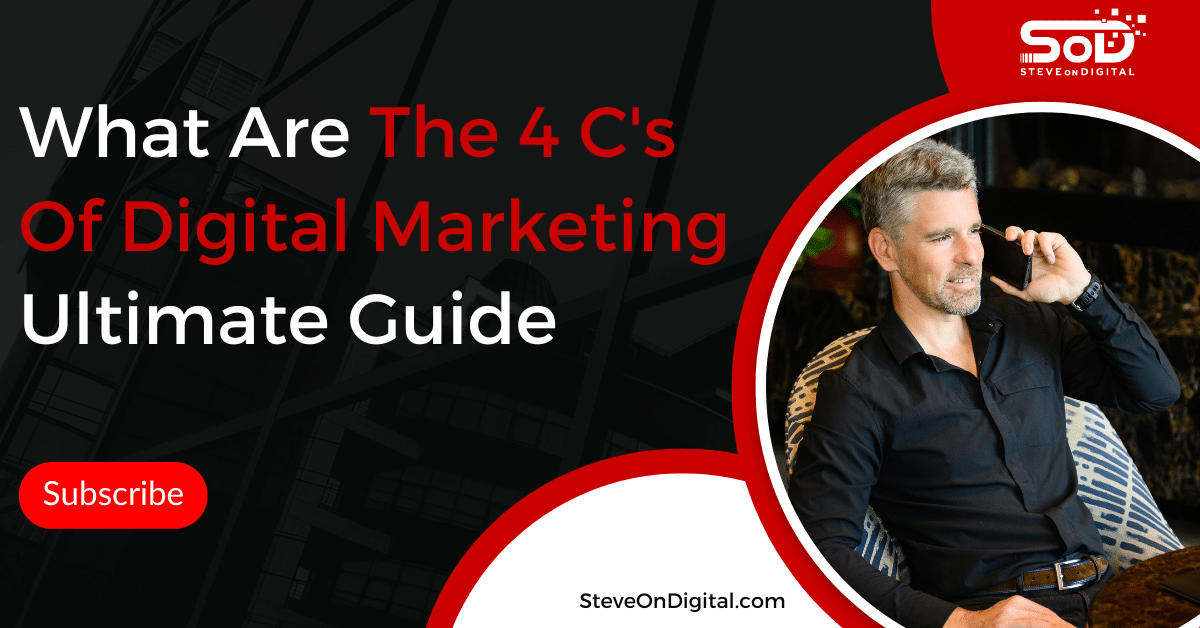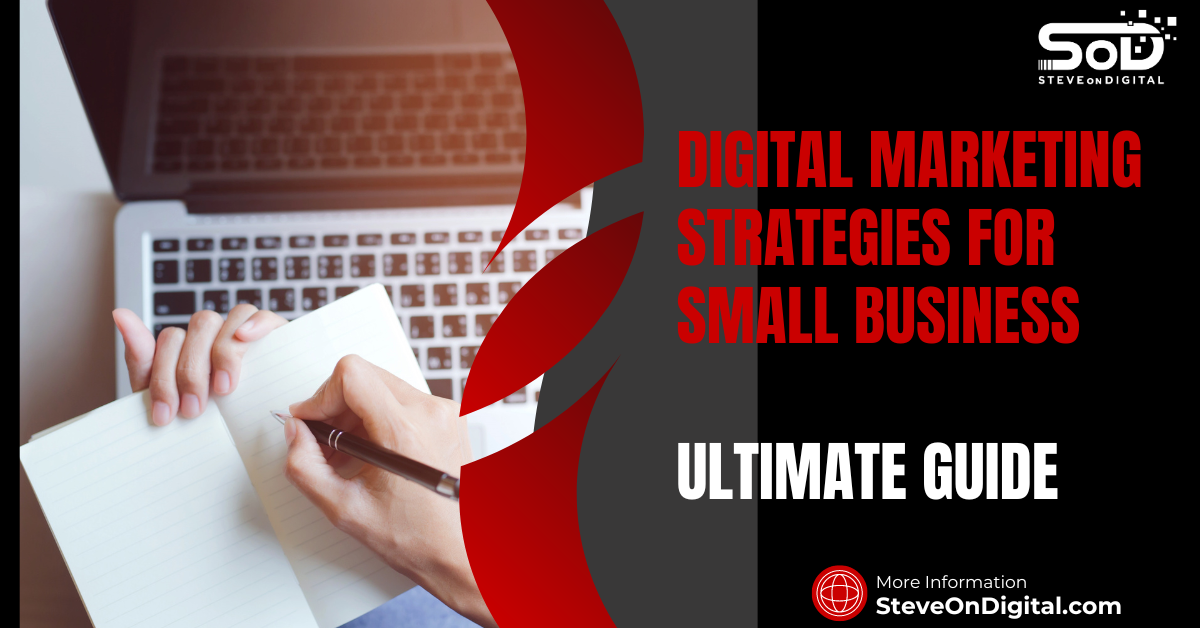What exactly is digital marketing, and why is it critical in today’s business environment?
As the owner of SteveOnDigital, my years navigating the intricacies of the digital world have shown me how vital digital marketing is for any business aiming to thrive in the modern marketplace.
Digital marketing encompasses all marketing efforts that use an electronic device or the internet.
Companies use the internet, like search engines, social media, email, and other websites, to talk to people who might buy their stuff, and also to keep talking to the people who already do.
In contrast to traditional advertising, digital marketing offers unprecedented opportunities to interact directly with consumers, often in real-time.
The Limitations Of The Traditional Marketing Mix
Traditionally, marketing strategies were often distilled into the 4Ps: Product, Price, Place, and Promotion.
While these elements are essential to understanding the marketing mix, they are not always suited to the demands of the digital age.
From my personal experience, and extensive work with smaller businesses at SteveOnDigital, it’s evident that the 4Ps often focus too narrowly on the company’s perspective rather than the customer’s needs.
In today’s digital landscape, where the consumer’s shopping experience and expectations have dramatically shifted towards online platforms, the 4Ps model can seem a bit outdated.
For instance, the “Place” in the 4Ps often alludes to physical locations like stores.
However, as more consumers shop online, the relevance of physical location diminishes, underscoring the need for a model that embraces the digital marketplace’s flexibility and reach.
Introducing The 4 C’s
The evolution from the traditional 4Ps to the more dynamic 4 C’s marks a pivotal shift from product-centric to customer-centric marketing.
This shift highlights the importance of focusing on what the audience needs and how they engage with the digital world.
Here Are The 4 C’s Explained
- Customer Needs And Wants: Instead of starting with the product, we start with the customer. What are they looking for? What problems are they trying to solve? As a digital marketing strategist, understanding the customer persona is the first step in crafting any effective marketing strategy.
- Cost To Satisfy: This goes beyond just the price of a product. It involves considering what customers are willing to invest, not just in terms of money but also time and effort. This understanding has guided the pricing strategies for my consultancy services, ensuring they deliver value and meet the budget expectations of my target market.
- Convenience To Buy: Making it easy for customers to purchase or engage is crucial in the digital age. This is why at SteveOnDigital, we’ve optimized our website and social media campaigns to ensure that our digital marketing services are easy to access and understand, aligning with how our clients prefer to engage and shop online.
- Communication: This C replaces Promotion, focusing on two-way communication rather than one-way sales messaging. In my practice, we leverage tools like email marketing and social media platforms not just to send messages but to listen and engage. Creating meaningful, online communication helps build a loyal customer base that feels valued and understood.
In conclusion, these 4 C’s form a robust framework that addresses the real needs of today’s digital consumers.
Decoding The 4 C’s
1. Customer
The key to success in digital marketing is building a deep understanding of your customers.
This means knowing who they are, what problems they face, and how they navigate the online world.

By tailoring your approach to their needs and online behavior, you can craft targeted campaigns that resonate with your audience.
- Crafting Buyer Personas: Developing detailed profiles of your ideal customers is crucial. As a digital marketing strategist, I often start by analyzing demographics, online behaviors, and preferences to craft comprehensive customer personas. These personas help tailor our digital marketing efforts, ensuring that we’re reaching the right audience with the right message.
- Unveiling Consumer Needs and Wants: Conducting market research is essential to identify what your consumers expect from your digital presence. Whether it’s convenience, information, or engagement, understanding these needs allows us to create more effective marketing strategies. For instance, in my work with SMEs, I’ve found that personalized content significantly boosts consumer engagement and satisfaction.
- Tailoring Strategies for Customer Delight: Creating digital experiences specifically designed to cater to individual consumer needs has always been my approach. Using tools like CRM software and data analytics, we can fine-tune our marketing communications to deliver highly personalized and relevant content that delights our customers, enhancing their overall shopping experience online.
2. Cost
Efficiently managing your marketing budget can drastically improve your digital marketing strategy’s return on investment.

- Setting Realistic Budgets: Understanding where to allocate resources effectively is paramount. By employing ROI calculations, businesses can ensure that every dollar spent contributes directly to overarching business goals. In my digital consultancy, we use performance data to adjust our spending continually, maximizing the effectiveness of every campaign.
- Exploring Cost-Effective Channels: Identifying and leveraging affordable marketing channels is key for smaller businesses. Social media and email marketing, for instance, offer cost-effective methods to reach a broad audience. These channels provide competitive advantages by allowing for direct and immediate communication with potential customers.
- Measuring Campaign Performance: To truly optimize costs, it’s crucial to measure the effectiveness of marketing campaigns. Using digital analytics tools, we track engagement rates, conversion rates, and overall campaign performance to fine-tune our strategies, ensuring resources are always well-spent.
3. Convenience
In today’s fast-paced digital world, convenience is king.

Making sure that customers can easily navigate your digital touchpoints can make or break their shopping experience.
- Designing a Seamless Online Experience: Ensuring your websites and apps are mobile-friendly with user-friendly interfaces is essential. In my practice, we emphasize responsive design and intuitive navigation to reduce friction, making it easier for customers to shop online.
- Omnichannel Marketing for Convenience: Utilizing multiple channels to engage customers ensures a smooth journey across different platforms. From social media to email to online stores, maintaining consistency across channels allows customers to interact with your brand at their convenience.
- The Power of Convenience: Demonstrating how convenience influences decisions is crucial. In my experience, customers are more likely to engage with brands that offer straightforward and efficient online shopping experiences.
4. Communication
Effective communication with your audience is essential for building trust and fostering long-term relationships.

- Crafting a Consistent Brand Message: Developing a clear, consistent brand voice that your target market can recognize and trust is fundamental. In my work, we focus on ensuring consistency across all digital platforms to build a strong, reliable brand image.
- Leveraging Effective Channels: Utilizing the right communication channels is crucial. In digital marketing, tools like social media, email marketing, and content marketing are invaluable for engaging customers in meaningful ways.
- Fostering Two-Way Communication: Encouraging customer feedback is a must for continuous improvement. Through social listening tools and online surveys, we actively seek out and respond to customer feedback, fostering a dialogue that helps improve our services and enhance customer satisfaction.
In conclusion, the 4 C’s of Digital Marketing—Customer, Cost, Convenience, and Communication—serve as a robust framework for developing a customer-centric digital marketing strategy.
Implementing The 4 C’s For Marketing Success
Developing A Winning Digital Marketing Strategy
The integration of the 4 C’s into your marketing plan is not just a strategic choice, but a necessary evolution in how we approach marketing in the digital age.
- Holistic Approach: When I craft digital marketing strategies at SteveOnDigital, I always start with a holistic view. It’s about seeing the big picture. How do customer needs, cost considerations, convenience factors, and communication methods converge to create a cohesive strategy? By considering these elements together, we ensure that each component of the marketing mix supports the others, leading to a more effective overall strategy.
- Customer-Centric Planning: This holistic approach allows us to focus on creating a customer-centric marketing strategy. Every decision, from channel selection to content creation, is driven by insights into the customer persona and consumer needs. This alignment ensures that we meet potential customers exactly where they are, providing them with value and solutions that resonate deeply.
Creating Targeted Marketing Campaigns
Specific goals and targeted campaigns are essential for cutting through the noise in the digital world.
- Relevant Messaging: Based on the detailed customer personas we develop, each campaign is tailored to speak directly to the interests and needs of our target audience. This isn’t about broad-spectrum appeal; it’s about connecting meaningfully with each segment of our audience.
- Goal-Oriented Campaigns: At SteveOnDigital, each marketing campaign is designed with clear objectives. Are we aiming to increase brand awareness, drive conversions, or improve customer retention? By defining these goals upfront, we can better measure the success and impact of our efforts, ensuring that we are not just active but effective in our marketing endeavors.
Building A Strong Brand Identity
A distinctive brand identity is crucial for standing out in a crowded market.
- Differentiation: By employing a clear positioning statement and maintaining brand consistency, we establish a recognizable and trusted brand identity. This consistency is key, as it helps to build trust and loyalty among customers, making them more likely to return and engage with our brand over time.
- Consistent Communication: I emphasize consistent communication across all platforms, from social media to email marketing. This ensures that our brand message is uniform, which helps in reinforcing our brand identity and aids in building a loyal customer base who trusts in the value we provide.
The 4 C’s vs. Traditional Marketing
Shifting Focus From Product To Customer
The transition from a product-centric to a customer-centric approach marks a significant shift in the marketing landscape.
- Customer Focus: Unlike traditional marketing, which often prioritizes the product (4Ps), the 4 C’s methodology centers around the customer. This approach not only aligns with the current consumer-driven market but also enhances customer satisfaction and loyalty by addressing the specific needs and desires of the audience.
The Importance Of Mental Flexibility
In the fast-paced digital world, adaptability is key.
- Evolving Strategies: The digital landscape is continuously changing, and mental flexibility allows marketers to adapt their strategies quickly. At SteveOnDigital, we stay on top of trends and adjust our strategies in real-time, ensuring that our marketing communications are always relevant and impactful.
The Power Of Data-Driven Decisions
Utilizing data analytics is fundamental in making informed marketing decisions.
- Informed Strategies: By analyzing data on customer behavior and feedback, we can make evidence-based decisions that significantly enhance the effectiveness of our marketing efforts. This data-driven approach not only helps in refining our marketing strategies but also ensures that we can deliver more personalized and effective marketing messages.
The 4 C’s Framework
Increased Customer Acquisition And Retention
Employing the 4 C’s of digital marketing effectively fosters both customer loyalty and a loyal customer base.
- Understanding Customer Needs: By focusing first and foremost on the customer—what they desire, need, and expect—we can create more targeted and engaging content. In my own business, SteveOnDigital, this approach has led to a notable increase in customer retention rates. Customers feel understood and valued, and therefore more likely to stick around and engage with our brand.
- Tailored Marketing Strategies: Each component of the 4 C’s contributes to a tailored marketing approach that speaks directly to the target audience. This customization makes marketing campaigns more effective, enhancing customer acquisition by appealing directly to the needs and desires of potential customers.
Enhanced Brand Awareness And Recognition
The 4 C’s framework plays a crucial role in building both brand trust and strong brand recognition.
- Consistent Brand Messaging: Consistency in communication across all platforms—be it social media, email, or online ads—helps establish a strong, cohesive brand image. This clear positioning statement is essential for being memorable in the competitive digital landscape.
- Engagement Through Value: Providing value through useful, informative, and engaging content is key to building brand trust. By focusing on delivering value at every point of communication, businesses can enhance their brand awareness and cement their reputation as trustworthy entities in their respective markets.
Improved Marketing ROI
A focus on cost-effectiveness inherent in the 4 C’s leads to a better return on marketing investments.
- Optimizing Budget Allocation: By strategically allocating resources based on the performance metrics of previous marketing campaigns, businesses can significantly reduce waste and increase the impact of their spending. In practice, this approach has allowed my clients to achieve more with their budgets, boosting their overall marketing ROI.
- Data-Driven Decisions: Utilizing data to guide decisions in marketing efforts ensures that every dollar spent is an investment towards reaching specific, measurable goals. This methodical approach to spending and strategy not only cuts costs but also improves the effectiveness of marketing campaigns.
The 4 C’s Advantage
A Scalable And Adaptable Framework
The 4 C’s framework provides a scalable and adaptable approach that is suitable for businesses of all sizes, particularly beneficial for growth in smaller businesses.
- Flexibility to Scale: Whether a company is looking to expand its reach, enter new markets, or refine its existing operations, the 4 C’s offer a flexible framework that can adjust to varying scales and needs. This adaptability makes it an ideal strategy for businesses at different stages of growth.
- Customizable for Various Industries: The principles of customer focus, cost efficiency, convenience, and communication are universal but can be tailored to the specific needs of any industry or market segment, enhancing their applicability and effectiveness across sectors.
Utilizing Free And Low-Cost Marketing Tools
For smaller businesses, managing budget constraints while maximizing marketing efficacy is a key challenge that the 4 C’s can address by leveraging free and low-cost tools.
- Social Media Platforms: Platforms like Facebook, Instagram, and Twitter provide powerful channels for digital marketing at little to no cost. These tools allow businesses to reach large audiences, engage with customers directly, and build brand awareness effectively.
- Email Marketing Software: Email marketing remains one of the most cost-effective digital marketing strategies. Using platforms like MailChimp or Sendinblue, businesses can manage email campaigns, automate communications, and measure their impact without significant investments.
Competing With Larger Businesses
The 4 C’s framework levels the playing field, allowing smaller businesses to gain a competitive edge against larger competitors.
- Nimble and Responsive Strategies: Smaller businesses can often act more swiftly than their larger counterparts, adapting quickly to market changes and customer feedback. This agility, when supported by a customer-centric approach like the 4 C’s, can lead to significant competitive advantages.
- Building Closer Customer Relationships: Smaller businesses have the opportunity to build more personal relationships with their customers. By leveraging the 4 C’s, these businesses can create highly personalized experiences that larger businesses often struggle to provide, resulting in greater customer loyalty and competitive differentiation.
The Future Of Digital Marketing
Predicting Consumer Behavior
As we look towards the future, understanding and predicting consumer behavior becomes increasingly crucial.
- Emerging Trends: Staying ahead in digital marketing means keeping an eye on emerging trends. In my experience at SteveOnDigital, adapting quickly to these trends has been essential. For instance, the increasing emphasis on sustainability has led us to adjust our marketing communications to highlight eco-friendly practices and products.
- Adapting the 4 C’s: The beauty of the 4 C’s is their adaptability. As consumer needs evolve, so does our approach. Understanding these shifts allows us to anticipate market changes and position our marketing strategies to meet the future needs of our target audience effectively.
The Rise Of Personalization
Personalization is becoming a cornerstone of successful digital marketing strategies.
- Importance of Customized Experiences: Consumers today expect more than just generic interactions; they seek personalized experiences tailored to their preferences and behaviors. At SteveOnDigital, we use data-driven insights to customize our marketing efforts, from email marketing campaigns to social media messages, ensuring that each touchpoint resonates personally with the audience.
- Leveraging the 4 C’s for Personalization: Each of the 4 C’s contributes to a deeper level of personalization. Understanding the customer (Customer), optimizing the cost for value (Cost), ensuring ease of access (Convenience), and maintaining open channels of communication (Communication) all help in crafting personalized experiences that connect and convert.
The Integration Of Artificial Intelligence (AI)
AI’s role in marketing is expanding, offering new ways to enhance the effectiveness of digital strategies.
- Potential of AI in Marketing: AI can automate complex data analysis to predict trends, personalize content, and optimize customer interactions. In my role as a digital strategist, integrating AI into our digital marketing strategy has allowed us to offer more precise and impactful marketing solutions.
- Utilizing AI with the 4 C’s: AI enhances how we apply the 4 C’s. For example, AI tools can analyze vast amounts of data to better understand customer needs and optimize communication strategies, making our marketing efforts more effective and efficient.
Case Studies
Showcase Real-World Examples
Here are some real-world examples where businesses have successfully implemented the 4 C’s framework, resulting in significant improvements in their marketing outcomes.
- Example 1: A local boutique that shifted its focus from traditional advertising to a customer-centric digital marketing strategy saw a 30% increase in online sales within six months. They achieved this by using social media campaigns tailored to their target audience’s preferences, enhancing their online shopping experience.
- Example 2: A tech startup utilized AI to analyze customer feedback and optimize their communication strategies. This led to improved customer satisfaction rates and a stronger customer base willing to advocate for the brand.
Analyze The Specific Strategies Employed By Each Business
- Customized Marketing Communications: These businesses excelled by tailoring their communications to meet specific consumer needs and preferences, demonstrating a clear understanding of their target market.
- Efficient Use of Resources: By focusing on cost-effective digital channels and leveraging technologies like AI, these companies optimized their marketing spend, proving that strategic investments in technology and channel selection could yield substantial returns.
| Business Type | Strategy Employed | Outcome Achieved |
| Local Boutique | Focused social media campaigns on new arrivals. | 30% increase in online sales within six months. |
| Tech Startup | Used AI for customer feedback analysis. | Improved customer satisfaction and retention. |
| Health Clinic | Developed a mobile-first booking system. | 40% increase in appointment bookings. |
Highlight The Positive Outcomes Achieved Through The 4 C’s Approach
- Increased Sales: By aligning their marketing strategies with the 4 C’s, businesses have seen tangible increases in sales and revenue, illustrating the direct benefits of a customer-centric approach.
- Improved Customer Satisfaction: The emphasis on understanding and meeting customer needs has not only retained customers but also turned them into loyal advocates for the brands, highlighting the importance of customer satisfaction in long-term business success.
Optimizing Your Marketing Efforts
The Importance of Measurement
To truly understand the impact of your digital marketing efforts, it’s crucial to measure their effectiveness using relevant metrics.
- Key Metrics: From my experience running SteveOnDigital, tracking website traffic, conversion rates, and customer engagement levels has always been foundational. These metrics provide clear insights into how well our marketing campaigns are performing and where there might be room for improvement.
- Regular Monitoring: Setting up regular monitoring using tools like Google Analytics allows us to see real-time results of our marketing activities. This ongoing assessment helps ensure that we’re not just operating in the dark but making informed decisions based on actual performance data.
| Metric | Description | Why It’s Important |
| Website Traffic | The number of visitors to your website. | Indicates the level of interest and reach of your site. |
| Conversion Rates | The percentage of visitors who complete a desired action. | Measures the effectiveness of your conversion mechanisms. |
| Customer Engagement | Engagement actions (likes, shares, comments) on platforms. | Shows how well audiences interact with your content. |
Data-Driven Adjustments
Leveraging data to refine and optimize your marketing strategies is essential for staying competitive in the digital landscape.
- Utilizing Insights: At SteveOnDigital, we analyze the data collected from our campaigns to understand what works and what doesn’t. This includes looking at user behavior on our website, engagement with our emails, and performance of our social media campaigns. Each piece of data helps us to fine-tune our approach, ensuring that we’re not only meeting but exceeding the needs of our target audience.
- Optimizing the 4 C’s: Based on these insights, adjustments are made to better align with the 4 C’s—whether it’s enhancing the online value proposition to boost customer engagement or revising our communication strategies to improve clarity and impact.
| 4 C’s Component | Adjustment Example | Expected Impact |
| Customer | Personalize email content based on user activity. | Increase in email open rates and conversions. |
| Cost | Shift budget towards high-performing social media channels. | Better ROI and reduced wasted expenditure. |
| Convenience | Simplify checkout process on mobile devices. | Higher conversion rates from mobile users. |
| Communication | Increase frequency of interactive posts. | Greater engagement and customer feedback. |
Continuously Evolving
The digital marketing world is never static, and neither should your marketing strategy be.
- Ongoing Evaluation: It’s crucial to continuously evaluate and adapt your marketing approach. This means staying updated with the latest digital marketing trends and consumer behaviors, and being ready to pivot your strategies in response to new information and technologies.
- Adaptation for Success: Embracing a flexible and responsive approach to digital marketing has been key to my success at SteveOnDigital. By continuously learning and adapting, we’ve been able to maintain a competitive edge and drive meaningful results in a rapidly changing digital world.
Conclusion
As we wrap up this deep dive into the 4 C’s of Digital Marketing, it’s clear that this framework isn’t just a method—it’s a compass for navigating the complex and ever-evolving digital landscape.
- Recap the Power of the 4 C’s: The 4 C’s—Customer, Cost, Convenience, and Communication—provide a robust framework for building digital marketing strategies that are not only effective but also deeply aligned with the needs of the modern consumer. These principles have guided my own journey in creating a successful digital presence for SteveOnDigital, helping to achieve remarkable improvements in customer satisfaction, market reach, and overall business growth.
- A Call to Action: For businesses looking to thrive in the digital age, adopting the 4 C’s is more than a recommendation—it’s a necessity. This approach ensures that your marketing efforts are customer-focused, cost-effective, convenient, and communicative, setting you up for success in a competitive digital marketplace.
- Embrace Continuous Learning: The digital world changes rapidly, and staying informed and adaptable is crucial. I encourage all businesses to embrace continuous learning and experimentation. It’s not just about keeping up—it’s about leading the way in your industry.
By integrating the 4 C’s into your marketing strategies and continuously refining your approach based on real-world data, you can not only meet the current demands of your target market but also anticipate future trends and changes.
This proactive approach to digital marketing is what will distinguish your business from competitors and drive long-term success in the digital age.





